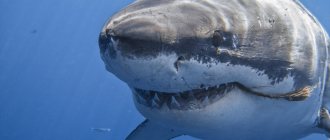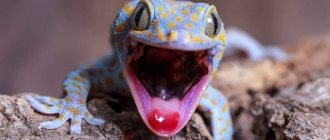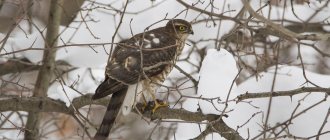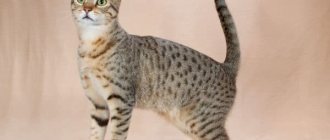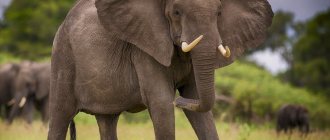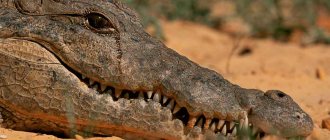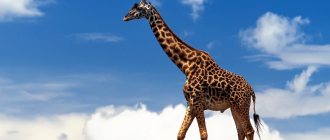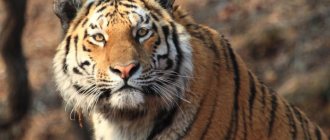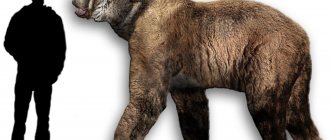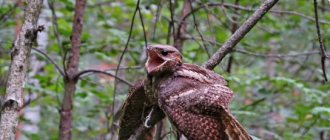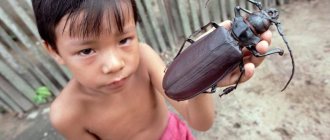| Latin name: | Spheniscidae |
| English name: | To be confirmed |
| Kingdom: | Animals |
| Type: | Chordata |
| Class: | Birds |
| Squad: | Penguin-like |
| Family: | Penguins |
| Genus: | To be confirmed |
| Body length: | 130 cm |
| Wing length: | To be confirmed |
| Wingspan: | To be confirmed |
| Weight: | 35000—40000 g |
Description of the bird
Photo of a penguin with chicks
All penguins have a streamlined body shape, well-developed muscles and wings that act like propellers under water. The keel is clearly defined on the sternum. The feet are large and short with a swimming membrane: on land, penguins often rest standing on their heels; the rigid plumage of the tail also serves as support for them. Penguins have a very short tail, since their steering function is performed by their legs, unlike other seabirds.
— Advertising —
The plumage of most species on the back is grayish-blue, which turns into black, and the belly is white. This color serves as a good camouflage for penguins. The cubs are gray or brown, sometimes with white sides and belly.
Penguins change plumage after hatching eggs and raising young. During the molting period, birds shed many feathers at once and become unable to swim, which is why they are deprived of the opportunity to obtain food for themselves until new feathers grow.
All penguins have a thick layer of fat, 2-3 cm, above which there are three layers of feathers: short, dense, waterproof. This reliable thermal insulation protects birds from exposure to extreme temperatures in their habitats.
Beneath the surface of the water, penguins make virtually no sounds; on land, they communicate using cries that are similar to the sounds of trumpets and rattles.
Penguin nutritional features
— Advertising —
Penguin got food for himself photo
The main food of penguins is fish: Antarctic silverfish, anchovies or sardines, as well as crustaceans (euphausiids, krill), small cephalopods. Penguins catch and swallow such prey directly under water.
Species that feed on small crustaceans require regular feeding. And penguins, who eat large fish, spend much less time and energy on hunting.
During the period of plumage change, and in some species also during hatching of chicks, birds completely refuse food. This period of fasting lasts from one month for Adélie and crested penguins to three and a half months for emperor penguins. At the same time, penguins lose about half of their body weight, as they use the energy of their fat reserves.
Penguins drink sea water. And excess salt is released through special glands that are located above their eyes.
Fifth place - longtip shark
Longwing shark
The habitat of the 3.5-meter shark, which received its name for its long pectoral fins reminiscent of bird wings, is the Pacific, Indian and Atlantic oceans. This predator prefers to navigate the waters alone. Its menu includes large fish, shellfish and squid. Possessing an excellent sense of smell, the sea monster not only senses the smell of prey, but also determines the location of its source. During a hunt, a shark does not know any sense of proportion - it hunts without even feeling hungry.
Until recently, there was an opinion that sharks extremely rarely approach the coastal zone and pose a danger only to people who have been shipwrecked or in a plane crash and who find themselves tens of kilometers from land. However, the events of recent years refute this fact. In 2010, long-winged sharks that appeared in the waters of the Egyptian Sharm el-Sheikh attacked several tourists. The answer to the question of what brought deep-sea predators to shallow waters has not been found.
Interesting: Myths about sharks - list, description, photos and videos
Bird distribution
Marked places on the map where penguins live
Penguins are common in the open seas of the Southern Hemisphere (coastal waters of Antarctica, New Zealand, southern Australia, South Africa, on the coast of South America from the Falkland Islands to Peru, on the Galapagos Islands).
These birds prefer cool climates, so they can appear in tropical latitudes only with cold currents
The warmest place where penguins live is the Galapagos Islands, which are located near the equator.
Third place - tiger shark
Tiger shark
You can recognize this ferocious predator by the presence of dark gray transverse stripes decorating its 4.5-meter body. The tiger shark's habitat is the coastal zone of Central America, the islands of Oceania, Australia, Africa, New Zealand and Southeast Asia. Sea nomads are also found in the warm waters of the Persian Gulf and the Red Sea. They go fishing mainly at night, and during the day they prefer to bask in the sun, swimming close to the beaches.
This huge fish does not specialize in specific prey. Her menu is amazingly diverse and includes any organic food. The toothy thunderstorm of the oceans easily splits the shell of a turtle, catches sea snakes, birds, dolphins and seals. She does not disdain carrion and edible waste from ship galleys. Objects that had nothing to do with food were found in the stomachs of caught tiger sharks: shoes, elements of anchor chains, bottles and car tires. A hungry hunter indiscriminately rushes at moving and stationary objects. A swift attack leaves the victim no chance. Every year, 3–5 tiger shark attacks on people are recorded worldwide.
Interesting: The most dangerous sharks of the Mediterranean Sea - list, names, description, habitat, photos and videos
Common types of penguins
Crested or rocky golden-crested penguin (Eudyptes chrysocome)
Crested penguin close-up
Body length 55-65 cm, weight from 2 to 3 kg. It lives on the islands of the Subantarctic, Tasmania and Tierra del Fuego, on the mainland coast of South America.
The plumage color is white below and bluish-black above. Narrow yellow “eyebrows” ending in tassels are noticeable on the face. There are black feathers on the top of the head. The wings are strong and narrow. The eyes are small. The legs are short.
Thick-billed penguin (Eudyptes pachyrhynchus)
A thick-billed penguin is examined in a photo.
Body length is from 55 to 60 cm, weight is 2-5 kg (on average 3 kg).
The head and body are painted black, the belly is white, and there are white spots on the cheeks. There are cross-shaped yellow stripes at the base of the beak. The chicks are grayish-brown on the back with a white breast and belly.
The species is widespread on the Stewart and Solander Islands and in New Zealand.
Snare crested penguin (Eudyptes robustus)
Snares crested penguin close-up photo
Endemic to the small Snares archipelago, with an area of 3.3 km², it is the smallest range of all penguins. About 30,000 pairs live in this territory.
Body length is about 55 cm, weight up to 4 kg. The back is black, the belly is white, the beak is red. There is a yellow crest above the eyes.
Schlegel's penguin (Eudyptes schlegeli)
Schlegel's penguin runs photo
Medium-sized penguin. Adults are 70 cm long and weigh about 6 kg. This species nests only on Macquarie Island. But it spends most of its life in the open ocean.
Externally, the Schlegel penguin resembles a golden-haired penguin.
Great crested penguin (Eudyptes sclateri)
A large crested penguin takes a closer look at the photo.
The bird's body length reaches 65 cm, weight from 4 to 5 kg. Females are smaller than males in size. The chicks are grayish-brown on the back and white on the belly. The plumage on the back, wings and head is black, the chin, throat and cheeks are white. From the nostrils through the dark red eyes along the top of the head there are two light yellow tufts. Unlike its closest relatives, the penguin can move its feather decoration.
Lives near Australia and New Zealand, nesting on the Antipodes, Bounty, Campbell and Auckland islands. The species is listed in the Red Book as endangered.
Golden-haired penguin (Eudyptes chrysolophus)
Female and male golden-haired penguin
Body length from 65 to 76 cm, body weight about 5 kg. The back and head are feathered black, the belly is white, and above the eyes there are tufts of golden-yellow feathers that form a characteristic crest.
Golden-haired penguins live in colonies in the southern Atlantic and Indian oceans. They nest on the islands of South Georgia, South Shetland, South Orkney, and South Sandwich.
Little penguin (Eudyptula minor)
A flock of small penguins photo
Body length from 30 to 40 cm, average weight 1.5 kg. The head, upper back and wings are blue. The back is dark, almost black, the chest and top of the legs are light gray or white. The beak is dark gray. Young birds are distinguished by a short beak and light color.
The species is distributed along the coasts of South Australia and New Zealand, as well as on nearby islands
White-winged penguin (Eudyptula albosignata)
White-winged penguin close up photo
A small species, up to 30 cm in length, weighing about 1.5 kg. Outwardly it resembles a small penguin, from which it differs in white spots on its flippers.
Breeds exclusively on Banks Peninsula and Motunau Island (New Zealand).
Yellow-eyed or magnificent penguin (Megadyptes antipodes)
A magnificent penguin walks on moss photo
Body length is from 70 to 75 cm, weight reaches 7 kg. The head is covered with feathers of golden yellow and black, the chin and throat are brown. The plumage on the back is black, on the chest - white, the legs and beak are red. The species got its name “yellow-eyed” because of the yellow stripe near the eyes.
A rare species, it lives on islands from the south of the South Island to the Campbell Archipelago.
Adelie penguin (Pygoscelis adeliae)
Adelie penguin in the white kingdom of snow photo
Body length about 70 cm, weight up to 6 kg. The back is black, the belly is white. There is a noticeable white ring around the eyes.
The breeding range of the species includes the coast of Antarctica and the nearest islands: South Shetland and Orkney.
Chinstrap penguin (Pygoscelis antarctica)
Chinstrap penguin close-up photo
Body length from 60 to 70 cm, weight about 4.5 kg. The back and head behind are dark gray, almost black, the belly is white. There is a thin black stripe on the neck, from ear to ear. The chicks are covered with gray down.
The distribution area of this species is the coast of Antarctica from South America.
Subantarctic or gentoo penguin (Pygoscelis papua)
Photo of a gentoo penguin on the rocks.
The largest species after the emperor and king penguins. Males reach a weight of 9 kg, females - 7.5 kg, body length ranges from 75 to 90 cm. The back is black, the belly is white. The beak is orange-red or red with a black tip, the legs are orange or dark orange.
Breeds on the Falkland, South Georgia, Kerguelen, Heard, South Orkney, Prince Edward and South Sandwich Islands.
Spectacled penguin (Spheniscus demersus)
Photo of a spectacled penguin near the water.
The largest representative of its genus. Its body length is 65-70 cm, weight is from 3 to 5 kg. The back is black, the belly is white. On the chest down to the paws there is a narrow black stripe in the shape of a horseshoe.
The species is distributed on the coast of South Africa and Namibia and nearby islands.
Galapagos penguin (Spheniscus mendiculus)
Galapagos penguin stands on a rock photo
Body length is about 50 cm, weight up to 2.5 kg. The head and back are painted black, a white stripe stretches from the throat up to the head and to the eyes, and the belly is white. The mandible and the tip of the mandible are black, the mandible and the skin around the eyes are pinkish-yellow.
The habitat of this species is unique - the Galapagos Islands, located near the equator.
Humboldt penguin or Peruvian penguin (Spheniscus humboldti)
Peruvian penguin screams photo
Medium-sized bird. The head and back are black, and there is a wide black ring on the white belly. On the sides of the head, through the forehead and throat, there are narrow white rings, the so-called “spectacles”. The beak is black with a red base, the legs are black.
The species breeds in Chile and Peru.
Magellanic penguin (Spheniscus magellanicus)
Penguin thought about photo
Body length from 70 to 80 cm, weight from 5 to 6 kg. The back is painted black, the belly is white, and there are one or two black stripes on the neck. The beak and legs are dirty gray, with a red or orange tint.
Breeds on the Patagonian coast, Tierra del Fuego, Juan Fernandez and Falkland Islands.
Second place - white shark
The great white shark
is called the “Queen of the Seas”, a legendary predator whose body length varies from 4.6 to 5 meters. The owner of five rows of teeth and keen eyes, capable of seeing in pitch darkness, hunts off the coast of waters of subtropical and tropical latitudes. The attack tactics are thought out to the smallest detail: the white shark tracks down its prey and inflicts numerous bites, repeating the attack over and over again. According to unofficial sources, between 20 and 30 attacks on people are recorded annually.
In addition to well-developed hearing, vision and smell, representatives of the large shark family have another natural gift - electroreception - the ability to perceive changes in magnetic and electric fields. It is impossible to hide from underwater hunters. Fierce creatures unerringly find even a victim buried in the sand, reacting to the beating of its heart and the movement of its gills. White sharks are most sensitive to vibrations. For this reason, you will not find the mistress of the seas in any aquarium in the world. Constant vibrations, noise and radiation from devices disrupt the delicate sensory perception of fish.
Penguin breeding
Penguin hatches an egg photo
Penguins nest in large colonies of ten thousand pairs or more. The age of nesting depends on the specific species, and the incubation time depends on the climatic conditions of the habitat.
Penguins living near the equator hatch chicks all year round, while others can only lay two clutches a year. The main nesting period is spring – autumn.
Males arrive at the colony earlier than females and occupy a small territory of about one square meter. Then they begin to attract the attention of females and emit cries that resemble the sound of a trumpet. Penguins often recreate last year's pairings, although they are not strictly monogamous birds.
Females lay eggs, one or two, in a nest, which is made of grass and small pebbles. Penguin eggs are white or greenish.
The duration of incubation is from one to two months. Both the male and the female take part in it, and they change, since the birds do not eat the eggs during incubation.
The first few weeks after birth, one of the parents watches the babies, and the other searches for food. Then the young animals form small groups, which are looked after by adults for some time.
Then the adult birds begin to molt, and the young birds move on to independent life.
The average life expectancy of penguins is about 25 years.
Interesting facts about the bird
Photo of a penguin swimming
- The average speed that a penguin can develop in water is 5-10 km/h. The fastest way of movement among penguins is called “dolphin swimming”; in this case, the bird jumps out of the water for a short time.
- During a day of hunting, a penguin swims about 27 km and spends about 80 minutes at a depth of more than 3 meters. The gentoo penguin can stay underwater for one to two minutes and dives to a depth of about 20 meters, but the emperor penguin remains underwater for up to 18 minutes and dives to a depth of about 500 meters.
- Coming out of the water onto the shore, penguins can jump to a height of up to 1.8 m. On land they waddle, and on ice they move quickly and cheerfully - they slide down slides while lying on their stomachs.
- In Central Europe and Russia, penguins are found only in zoos.
- The largest representative of penguins is the emperor penguin (height about 130 cm, weight up to 40 kg), and the smallest is the little penguin (height from 30 to 45 cm, weight 1-2.5 kg).
American marten behavior
The American marten is active early in the morning and at night.
Except for the breeding season, it leads a solitary lifestyle. Males guard their territories of about 8 km2, which can overlap the territories of females (area about 2.5 km2). Animals regularly walk around their area, at least once a week. The area of an individual plot depends on the animal’s body size, the presence of fallen trees, and the abundance and suitability of the food supply. American martens of the same sex show high aggression towards each other, especially if they encounter a stranger on their territory. American martens live both sedentary and migratory. The latter is more typical for young individuals. As they age, large males occupy the largest areas, trying to select them so that they overlap as much as possible with the territory of females. The marten is very agile. She easily jumps along the branches of trees, while marking the path of movement with the smell of her glands. It hunts alone, killing prey with a bite to the back of the head, after which it destroys its spinal cord and breaks its cervical vertebrae. In winter, the marten digs tunnels under the snow in which it looks for mouse-like rodents.
To communicate with each other, American martens use characteristic sounds that sound like screams and giggles.
